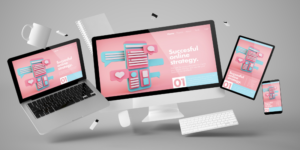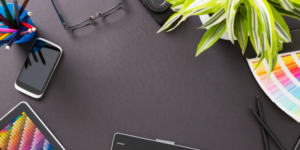The evolution of technology has had a significant impact on the field of design. As new technologies emerge and develop, they bring along a host of trends that are transforming the creative landscape. In this article, we will explore the impact of technology on design and the most relevant trends that are shaping the industry today.
Augmented Reality and Virtual Reality
One of the most prominent trends in current design is the use of Augmented Reality (AR) and Virtual Reality (VR). These technologies offer new possibilities for creating immersive and interactive experiences. Design can now transcend physical limitations and provide users with engaging and impactful experiences.
Responsive and Adaptive Design
With the increasing use of mobile devices and different screen sizes, responsive and adaptive design has become a necessity. Designers are creating flexible interfaces that automatically adjust to the device and usage context, ensuring a consistent and optimized experience across all devices.
Artificial Intelligence and Generative Design
Artificial Intelligence (AI) is revolutionizing design by enabling the creation of more efficient and personalized solutions. Machine learning algorithms can analyze data and patterns to provide valuable insights to designers. Additionally, generative design uses AI to generate design options based on specific criteria, opening up new creative possibilities.
Sustainable and Eco-friendly Design
The growing concern for the environment has led to the emergence of sustainable and eco-friendly design. Designers are increasingly aware of the ecological footprint of their projects and are adopting sustainable practices and materials. This trend reflects a shift in the design mindset, seeking solutions that are environmentally responsible.
Conversational Interface Design
With the rising popularity of virtual assistants and chatbots, conversational interface design has gained prominence. Designers are creating intuitive interfaces that enable natural interactions through voice commands or text messages. This trend aims to improve the user experience by offering a more fluid and efficient dialogue.
Minimalist Design and Expressive Typography
Minimalist design continues to be a strong trend, with its focus on simplicity and the removal of excess. Additionally, expressive typography has emerged as a way to convey emotion and personality through words. Careful use of typography can add an extra dimension to the design and create a deeper connection with the audience.
Conclusion
The impact of technology on design is evident across various areas, from creating immersive experiences to data-driven personalization and sustainability. As technology continues to evolve, it is essential for designers to keep up with emerging trends to remain relevant and innovative. By embracing these trends, designers can create creative and impactful solutions, offering meaningful experiences to the audience. The future of design is inherently linked to the advancement of technology, and it is up to designers to embrace these changes and explore the full potential they offer.
As augmented reality and virtual reality become more accessible, designers have the opportunity to create engaging and immersive experiences that transcend physical boundaries. The ability to transport users into virtual environments and provide interactive interactions opens up new creative possibilities and sets new standards for user experience.
Furthermore, responsive and adaptive design has become essential in today’s world, where devices of different sizes and formats are used to access online content. Designers need to ensure that their creations are flexible and adapt to any device, providing a consistent and optimized experience for all users.
Artificial intelligence and generative design are enabling designers to tackle complex challenges more efficiently. With machine learning algorithms, they can analyze large volumes of data and gain valuable insights to inform their design decisions. Additionally, generative design offers an innovative approach, allowing machines to generate design options based on specific criteria, expanding the creative horizon and accelerating the design process.
The growing concern for sustainability is driving eco-friendly and sustainable design. Designers are increasingly aware of the environmental impact of their creations and are adopting more sustainable practices and materials. This trend reflects a shift in the design mindset, seeking responsible solutions that consider the environment and promote long-term sustainability.
Conversational interface design is becoming increasingly relevant as interaction through virtual assistants and chatbots becomes common. The goal is to create intuitive interfaces that enable natural communication through voice commands or text messages. This approach aims to enhance the user experience by providing a more seamless and efficient interaction.
Minimalism in design continues to be a strong trend, with its approach of simplifying and removing excess. The combination of minimal visual elements with expressive typography offers an interesting balance between visually appealing and functional design. Careful typography choices can add an extra dimension to the design and create a deeper connection with the audience.
As we venture into the future of design, it is crucial for designers to be aware of new trends and adapt to ever-evolving technological changes. The speed at which technology is advancing requires an agile mindset and a willingness to embrace innovation. By understanding emerging trends and applying them creatively and strategically, designers can achieve impactful and meaningful results in their projects.
The impact of technology on design is an ongoing and dynamic phenomenon. As new technologies emerge and society evolves, design also transforms to keep up with these changes. Designers play a crucial role in shaping the future of design by exploring and experimenting with the possibilities offered by technology.
Ultimately, the ultimate goal of design is to create meaningful and impactful solutions that meet the needs of users and provide a visually pleasant and memorable experience. Understanding the impact of technology and being aware of emerging trends are essential components for the ongoing success of designers. By embracing the potential of technology and combining it with creativity, aesthetic sensitivity, and understanding of user needs, designers can play a vital role in building a visually stimulating and engaging future.
Design is constantly evolving and reinventing itself, and designers must be willing to explore new frontiers and challenge existing conventions. By staying up-to-date with technological trends and understanding how to apply them strategically and innovatively, designers can create experiences that go beyond aesthetics and evoke deep emotions in users.
The future of design is full of exciting possibilities, and it is up to designers to embrace change, experiment, learn, and create solutions that are truly impactful. By combining technical skills, creative vision, and understanding of the target audience, designers have the power to influence and shape how we interact with the digital and physical world.
Ultimately, the impact of technology on design is an ongoing and exciting journey, and designers play a vital role in that journey. By embracing technological trends, adapting to changes, and embracing creativity, designers can unlock a world of possibilities and create truly transformative visual experiences. The future of design is in the hands of visionaries, and it is a future filled with innovation, inspiration, and endless opportunities.



